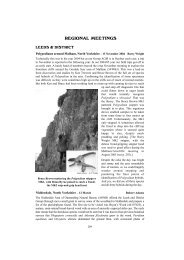Full Contents as pdf File - Natural History Museum
Full Contents as pdf File - Natural History Museum
Full Contents as pdf File - Natural History Museum
You also want an ePaper? Increase the reach of your titles
YUMPU automatically turns print PDFs into web optimized ePapers that Google loves.
After lunch we moved on to the Rhododendron Species Botanical Garden where the Hardy<br />
Fern Foundation holds its principal collection. We were shown around mainly by Michelle<br />
Bundy and Becky Reimer. Initially we admired the large number of plants waiting to be<br />
installed in the gardens and then, in baking heat, we slowly toured the wide collection of<br />
ferns in the garden itself, spread, I guess, over several acres. Unusually most taxa were<br />
represented by many plants; for example there could e<strong>as</strong>ily have been 50 plants of<br />
Polystichum polyblepharum in one drift. Elsewhere much smaller numbers represented rarer<br />
species. One plant of particular interest to me w<strong>as</strong> Blechnum niponicum. It w<strong>as</strong> very<br />
interesting to see it here, reinforcing my opinion that the populations of Pacific Northwest<br />
B. spicant are not the same <strong>as</strong> in Europe but have something of the ‘giz’ of B. niponicum in<br />
them. Cultivars were few but room w<strong>as</strong> found for Blechnum spicant ‘Serratum Rickard’!<br />
The whole garden w<strong>as</strong> immaculate. At the time of our visit, many of the ferns were still fairly<br />
young, but plenty of room had been left for each plant to eventually show its full potential.<br />
In a splendid collection like this there were a large number of ferns that are uncommon or<br />
absent in British gardens but seemed to be relatively widespread in the Seattle area,<br />
e.g. Cyrtomium macrophyllum, Dryopteris x australis, D. bissetiana, D. championii,<br />
D. cystolepidota, D. formosana, D. indusiata, D. k<strong>as</strong>hmiriana, D. lepidopoda, D. namegatae,<br />
D. scottii, D. uniformis, Polystichum neolobatum and P. retrosopaleaceum. One or two<br />
ferns grown here would struggle in central England, e.g. Doodia media, Hypolepis<br />
punctata, Rumohra adiantiformis and Arachniodes simplicior. Clearly the climate is milder<br />
in Seattle, the coldest recorded l<strong>as</strong>t winter w<strong>as</strong> -2ºC – wouldn’t I just love a climate like<br />
that! Despite the soft climate, tree-ferns are rare – there were none in this garden, but one or<br />
two were seen elsewhere, e.g. young plants of Dicksonia antarctica with a few inches of<br />
trunk, one Cyathea cooperi with about 12 inches of trunk in Willana Bradner’s garden and<br />
a truly magnificent specimen of Dicksonia fibrosa in Sylvia Duryee’s garden. Later in the<br />
week, I saw that Dicksonia antarctica and Cyathea cooperi were common further south in<br />
California.<br />
Mount Rainier (Monday) John Scott<br />
This w<strong>as</strong> an early day, leaving the University of W<strong>as</strong>hington at 7.30a.m. for our sojourn on<br />
Mount Rainier. On a clear day one can theoretically see Mt Rainier, rising 14,410 feet<br />
above sea level, from Seattle, which according to my topography map is 60 miles away. As<br />
we travelled on Route 410 I couldn’t resist taking pictures, though shooting from a moving<br />
bus through a spotty window doesn’t give the best results.<br />
Our first stop w<strong>as</strong> a viewpoint at Tipsoo Lake, with a wonderful view of Mt Rainier about<br />
ten miles away and a profusion of avalanche lily (Erythronium montanum).<br />
Our second stop w<strong>as</strong> the ‘Grove of the Patriarchs’, a marvellous stand of Dougl<strong>as</strong> fir and<br />
our only really good look at the ferns of Mt Rainier. While the list of the Park’s<br />
pteridophytes that we were provided with contained 49 species, I recorded only six.<br />
Botrychium lanceolatum w<strong>as</strong> a second find for me, having only seen it for the first time the<br />
previous summer in New Jersey. Even though B. multifidum occurs in the e<strong>as</strong>t, this w<strong>as</strong> my<br />
first sighting. The remaining ferns, western species not seen in the e<strong>as</strong>t at all, included<br />
Dryopteris expansa, Gymnocarpium disjunctum with yellow streaks, Polypodium<br />
hesperium and Polystichum munitum. Our western guides were calling all of their oak ferns<br />
G. disjunctum, though the Flora of North America shows both G. disjunctum and<br />
G. dryopteris in the Northwest. These plants looked like G. dryopteris to me!<br />
Our third stop w<strong>as</strong> Reflection Lake, aptly named <strong>as</strong> we could see a mirror-image of Mt<br />
Rainier in the water. In the wet seep across the road w<strong>as</strong> a profusion of colour: red<br />
C<strong>as</strong>telleja parviflora, white avalanche lily, blue lupine (Lupinus latifolius), pink<br />
Eupatorium occidentale and dark pink buds of Phyllodoce empetriformis.<br />
104

















